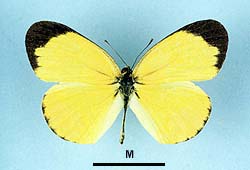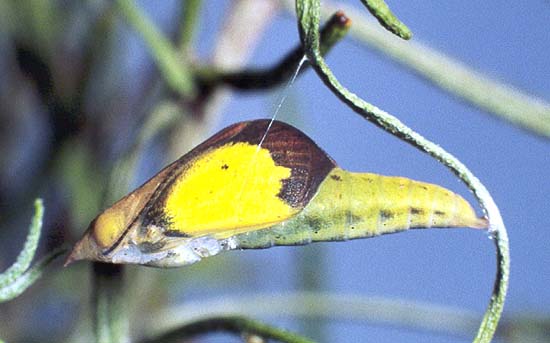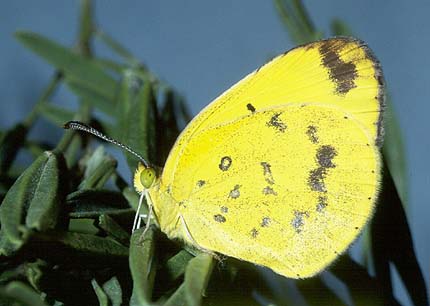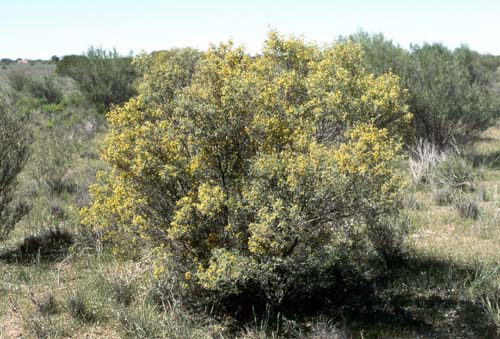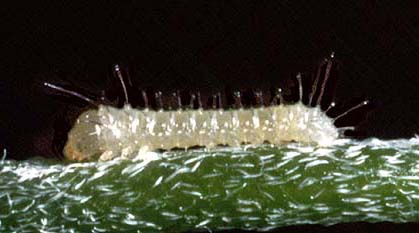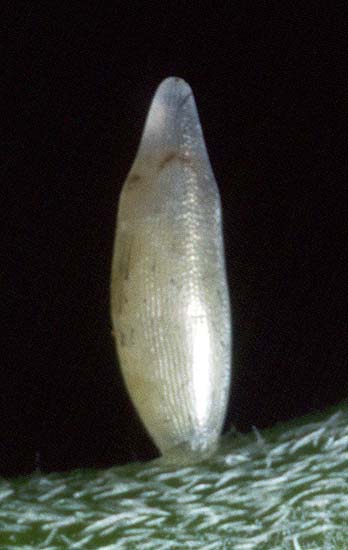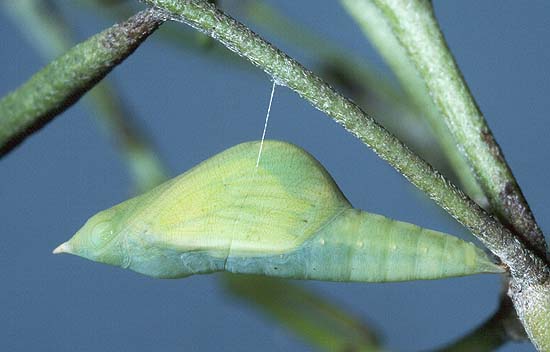-
Larval Food Host
-
Cassia and Senna species, including *C. fistula,
S. artemisioides coriacea (punty bush or desert cassia),
S. artemisioides petiolaris
(tomentose form - grey cassia, and the glabrous form) (Caesalpiniaceae);
also Neptunia species and **Paraserianthes (Albizia)
lophantha lophantha (Cape Leeuwin wattle) (Mimosaceae).
The preferred hostplant is Senna artemisioides. The larvae usually eat
the softer green parts of the hostplants including young seedpods, and will
sometimes eat the flowers.
-
Eggs
-
Initially white, later turning yellowish, long spindle shaped with numerous
very fine indistinct vertical ribs, and with the height slightly more than
thrice the diameter, the lower half tapering to a flat base, the upper half
tapering to a blunt point. Laid singly on the green parts of the hostplant,
usually on the leaves. Females tend to lay eggs on very small, young plants.
In the southern areas, eggs hatch in about 7-11 days during spring.
-
Larvae
-
Initially pale yellow, long cylindrical shaped, the skin is shiny, with sparse,
dark coloured fine hairs arising from pale coloured, simple raised bases.
These hairs are longest at the anterior and posterior ends of the larvae.
The head is pale yellow, large, rounded, smooth and shining, with a few dark
hairs. The larvae eat their egg shells first, then follow with whatever the
eggs were laid on. After eating the hostplant, the larvae become greenish
(unless they eat flowers). Initially these immature larvae scour the hostplant
surface, be it leaf, bark, young pod cuticle or flowers. Older larvae devour
whole leaves and young stems.
All stages of the larvae have special white-based glandular setae (hairs), which
secrete poison, visible at the ends of the hairs as clear coloured droplets. The
composition of the fluid is unknown, but is likely to be a deterrent to both
invertebrate and small vertebrate predators, as the hostplants contain irritant
poisons, which the larvae are capable of assimilating. This affords some
protection to the larvae while they feed openly on the hostplant during the day.
The second instar is similar to the first. Subsequent instars acquire abundant
short setae, which impart a rough scabrous appearance. The third and fourth
instars are yellowish green coloured with a darker dorsal line and a yellow
lateral line.
Mature larvae are long cylindrical shaped, 18-22 mm long, green with a dark green
dorsal line and a yellowish white lateral line. Near pupation, the lateral line
separates a distinct colour change in the larvae from whitish green above to
yellowish green below the line. The upper surface of the larva is covered in
abundant, poison tipped setae, which are mostly short, but there are some
interspersed longer setae. The head is a uniform green colour, and is covered
in short setae. The larvae are extremely well camouflaged on the hostplant and
very difficult to detect. The larval duration in southern areas is about 4-6 weeks.
-
Pupae
-
Elongate, about 15 mm long, the wing areas have a slightly wrinkled appearance,
laterally compressed with the wings compressed and extended into a prominently
bowed ventral keel typical for the subfamily, and without major protuberances
except for a spinose anterior projection. The thorax is slightly bulging dorsally,
and the lateral side of the pupa where the wings meet the thorax are slightly
keeled. Green coloured, the dorsal area is whitish and the ventral areas are
yellowish, and the lateral wing keel and the lateral side of the abdomen may
be pale yellowish. There is a lateral abdominal row of small yellow spots
(spiracles), and the anterior projection is normally yellow. There are usually
a series of small black spots along the outer edges of the wings, and again as
a subdorsal row along the abdomen. In some dark pupae there may be an indistinct
purplish dorsal and lateral line, the anterior projection may be purple tipped,
and there may be a dusting of purplish or other dark markings. Suspended by the
cremaster and a central silken girdle, usually to a stem or leaf of the hostplant,
but the larva may leave the hostplant if the plant is of small stature and pupate
on adjacent plants. The pupation position is random, and pupation may occur with
the head pointing either upwards or downwards. The pupal period is about 8-13 days,
decreasing in warmer weather.
-
Flight Period in South Australia
-
In northern pastoral areas it is possible to find the butterfly throughout the year.
In the southern settled areas it is most commonly seen in the spring during its main
southerly migration. It is sometimes seen again in fewer numbers during late summer
or autumn in these latter areas, possibly as a result of local breeding but usually
due as a result of a secondary migration from northern breeding areas after good
summer monsoon rains or thunderstorms in those areas. Migrating numbers around
Adelaide are very scarce in early spring, becoming more numerous in mid spring,
but then decline again in late spring to be rarely observed. However, migration
numbers fluctuate from year to year, as in some years it is entirely absent from
the southern areas. The brood period is about 8 weeks in southern areas, but is
considerably shorter in the hotter Far North areas of the state.

-
Distribution
-
Due to its migrant and vagrant habits, the butterfly can occur throughout mainland
Australia, with the odd occurrence on Kangaroo Island and Tasmania. It is most
common in the tropical and subtropical north of Australia. Readily breeds in the
northern pastoral and northern agricultural areas of South Australia where its
hostplants occur. Rarely takes up residence in southern settled areas even if its
hostplant is present.
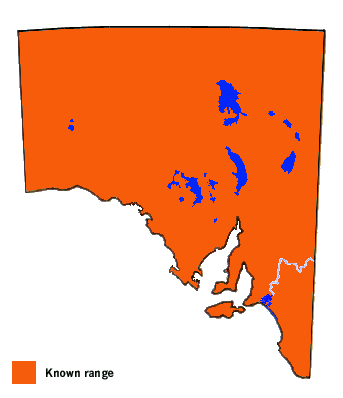
-
Habitat
-
The hostplants are common and are found in most inland habitats.
-
Conservation Status in South Australia
-
A migrant, locally common in breeding areas and during migrations.
-
Threats
-
No major threats.
-
Conservation Strategy
-
None required. The hostplants are very common in the inland areas of
the state and are not eaten by stock.
